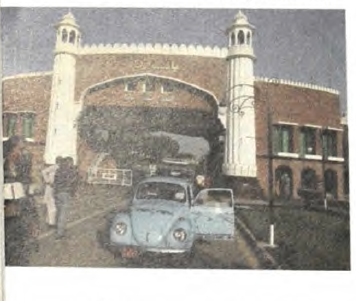From Himal Southasian, Volume 24, Number 12 (JAN 2011)
PESHAWAR, 16 November: We hopped into the sky-blue Volkswagen Beetle on 4 November in Kathmandu, being seen off by Nepal President Ram Baran Yadav, and have now arrived here in the capital of Khyber Pakhtunkhwah. We have completed all of 1100 miles for the sake of regional connectivity and spinal-injury awareness, and to raise funds to support victims of spinal injuries in Nepal.

The self-consciously titled ‘Great Nepal-India-Pakistan Spinal Beetle Drive’ took the 1973 model ‘Spinal Beetle’ from Kathmandu through Lucknow, Agra, Delhi, Amritsar, Lahore, Islamabad and Rawalpindi. As we switched off the ignition we told those who had gathered to welcome us in Peshawar: ‘It was an exhilarating journey across the friendly landmass of Southasia, and perhaps a pointer towards easy land-crossings for people from all our countries. If an old Beetle can do with ease, what are we waiting for?’
Most of our journey was along the ancient route that became the Grand Trunk Road, regularised by Sher Shah Suri during the 16th century. This context gave rise to another quote: ‘The 21st century demands that we open this highway for people, commerce and ideas to flow. Land connectivity is important because airline links cannot provide the mass-level contact that our people and economies deserve. We should build the same cacophony at the Atari-Wagah frontier as at the Nepal-India border of Bhairahawa-Sunauli.’
Among the many interesting aspects of the road trip, from the geographical to the emotional and historical, I would include the following:
- There is no ridgeline that separates the Ravi and the Jamuna, the Indus-Ganga plain is indeed correctly written in the singular! The Spinal Beetle sped along the brand-new divided highways of India and Pakistan as if a fish in water, or a freshwater dolphin in the Indus-Ganga.
- The Spinal Beetle team responded to the request of 96-year-old Barkat Singh ‘Pahalwan’ of Jalandhar (Indian Punjab), making a detour to his childhood village of Fatehgarh near Sialkot (Pakistani Punjab) and collecting a jarful of soil for the old gentleman.
- The memory of Sher Shah Suri, the Afghan sultan from present-day Bihar who ruled from Agra, followed us through much of the route. His memory was there in the ‘kos’ markers along the Delhi-Chandigarh stretch of the GT Road, a neglected postal station outside Wazirabad in the Pakistani Punjab, the great roadside banyans meant to shade resting travellers, and the Rohtas Fort on the approach to Rawalpindi.
- Having started in the Lumbini area of Nepal, where the Sakyamuni Buddha was born, the Spinal Beetle ended its journey in the Gandhar region around Peshawar, a land of Buddhist learning where the Sakyamuni was first etched in human form. On the Potohar Plateau near Islamabad, our fingers touched the gigantic Buddhist stupa in the village of Manikyal.
- The Delhi-Amritsar leg of our trip was started from the dargah of the Sufi saint Nizamuddin Aulia, a bit of old Delhi in New Delhi. The team visited the Taj Mahal on the day of Eid ul-Azha and Harminder Saheb on Guru Nanak’s birthday. Passing Gorkha district of Nepal, we traversed Gorakhpur, the centre of the Nath sect, and ended our journey in old Peshawar at the Gorakhnath temple, opened this October after 60 years of closure.
- After watching the mock-militarist show at the Wagah-Atari border between the goose-stepping Indian and Pakistani men in khaki, that very evening in Lahore we attended a play on Bhagat Singh and his fight for Indian independence put up by the Ajoka ensemble.
- The Bharatpur hospital in Nepal sought assistance in setting up a spinal-rehabilitation unit, while gifting NPR 50,000 to speed the Spinal Beetle on its way. In Agra, members of the Indian Doctors for Peace and Development, who hosted us, lamented that even with eight or nine neurosurgeons, their city did not have a rehabilitation centre. In New Delhi, Major H P S Ahluwalia, founder of Indian Spinal Injuries Centre, suggested that work begin on a Subcontinental network for spinal-injury rehabilitation. The Mayo Hospital in Lahore graciously offered full four-year fellowships on rehabilitation medicine for two doctors from our centre.
- In Islamabad, the Nepal team gathered information on the response to the 2005 earthquake that hit Kashmir and the Hazara division. The Pakistani experience will be critical in helping Nepal tackle the mega-tremor that is projected to hit before long. We also visited the Melody Theatre in Islamabad, which served as a staging ground for the sudden rush of spinal victims in 2005.
- The Volkswagen Club of Pakistan (VCP) took the Spinal Beetle under its wing in Islamabad, making sure that the car was made ship-shape after its Subcontinental voyage. Though this will be easier said than done, we decided to work on a VW Beetle rally from Islamabad all the way to Dhaka, through Delhi and Kathmandu. This period of thaw in relations between New Delhi, Dhaka and Islamabad was the time to push the plan. The VCP, meanwhile, took the Spinal Beetle’s rear bumper and had it painted like the artful livery of a Pakistani truck. What a gift!
So, did the journey raise the necessary money? Unfortunately, only about half of the USD 110,000 we had targeted at the ‘rate’ of USD 100 per mile. We now plan to raise the full amount through a ‘retroactive campaign’ that will end with the 10th anniversary of the Spinal Centre – Nepal in April 2012. Do tell someone you know!